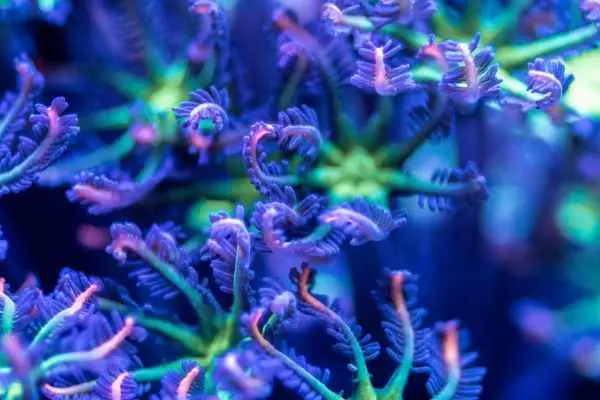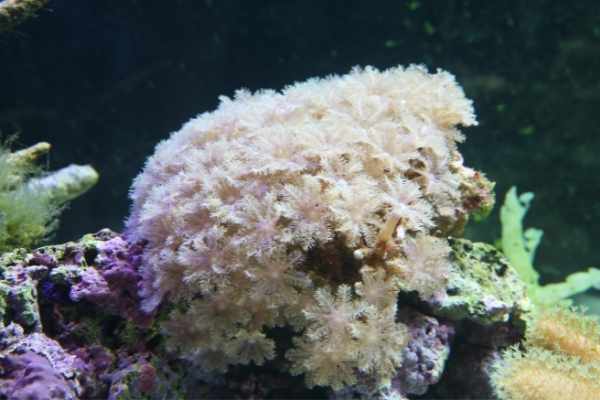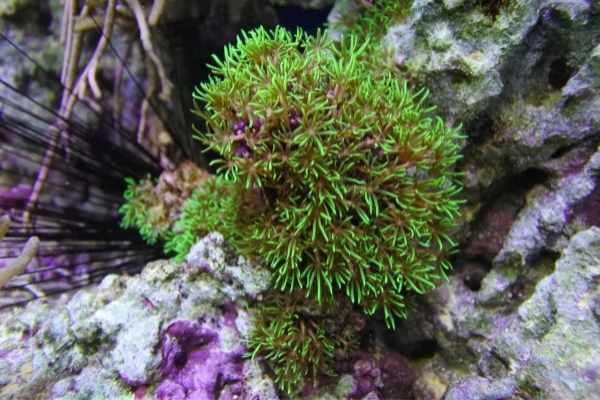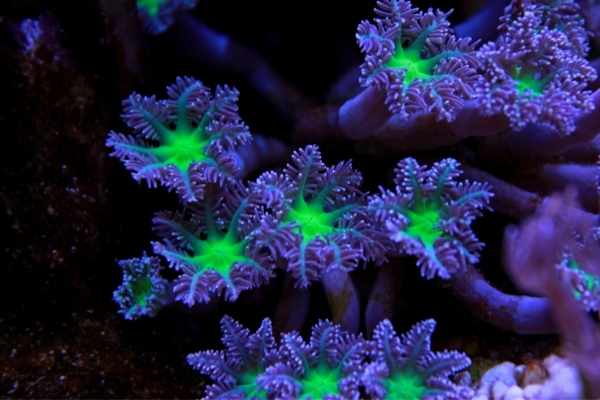Clove polyps (Clavularia spp.) create the perfect saltwater aquarium display. Their feathery “fronds” sway back and forth in the current, resembling clusters of ferns or palm trees. And you can find them in every color imaginable. Of course, as with any coral species, there are one or two hiccups in their management to worry about. (But that’s why you’re here, right?)
Table of Contents: Clove Polyps Care
For hobbyists researching soft corals, you can’t go wrong with clove polyps. They’re readily available (without breaking the bank), interesting to look at, and won’t drive you crazy in their care demands. Of course, no coral species is perfect. So click through the topics in the links below to make sure you REALLY want to add one of these feathery beauties to your reef tank.
- Quick Facts
- Description of Clove Polyps
- Creating the Ideal Clove Polyp World
- Clove Polyp Feeding
- Clove Polyp Behavior and Tank Mates
- Clove Polyp Reproduction and Fragging
- Pros and Cons
- For More Information

Quick Facts
- Common Names: Clove polyps, Eight tentacle polyps, Encrusting polyps, Clavularia clove polyps, Fern polyps, Glove polyps, Palm tree polyps, Daisy polyps
- Scientific Names: Clavularia spp.
- Size: 2-3 inches (5-7.6cm) in height
- Minimum Tank Size: 10 Gallons (39L)
- Aggression Level: Peaceful
- Compatibility: Can overgrow other corals, but no sweeper tentacles
- Care or Experience Level: Easy
- Feeding Recommended? Debatable
- Lighting: Moderate
- Water Flow: Moderate-High
- Original Part of the World: Indo-Pacific; 1 species in Atlantic
Description of Clove Polyps
Clove polyps belong to the Octocorallia group of soft corals. Or – as you probably guessed – corals with eight polyp segments. The polyps extend from tubes known as calyces. And when the “feathers” detect any threat – say, a predator or a hobbyist’s hand – they retract into the calyces. All you’ll see is a colorful lump of stone.
It’s the easiest way to tell clove polyps apart from waving hand corals (Anthelia spp.). Both genera have leafy polyps that sway in the current. But waving hand corals can’t retract into a calyx. You still see part of the tentacles exposed when they “deflate.” (Not that spooking corals in the fish store to check is recommended)
Clove polyps form colonies through stolons. You can spot the stolons by looking for vine-like structures between individual calyces. The stolons spread out and provide the colony’s base. Sometimes you’ll see spreading mats, and other times you’ll get a “bouquet” of waving tentacles. It depends on the available rock structure for the polyps to attach to.

The feathery tentacles are the most attractive part of a clove polyp. Fluffy or feathery extensions put people in mind of flowers, ferns, or palm trees. And as they drift in a current, they look very plant-like. Not every species looks that fancy, though. Some have thinner tentacles, always in a count of eight.
You’ll find plenty of colors to choose from: brown, cream, green, orange, purple, white, or yellow (to start). Usually, the center of the polyp is lighter than the feathery ends of the tentacles. But you can also find clove polyps that are solid in their coloration. And – courtesy of selective propagation techniques – you’ll even find those that fluoresce under moon lighting. Of course, the more unique the pattern or shade, the more difficult to find (and the higher the price tag).
Creating the Ideal Clove Polyp World
Clove polyps show up on reefs throughout the Indo-Pacific. Well, with one exception. (Clavularia modesto makes itself at home in the Atlantic) Otherwise, you’ll see those waving fronds around the Great Barrier Reef, Fiji, Tonga, the Solomon Islands, and Hawaii. They’re hard to miss.
The stolons adhere to rocky surfaces in shallower waters. This provides the light intensity the polyps need to feed their zooxanthellae. And the wave action of the nearby shoreline delivers plankton to the waiting tentacles. Since stolons act as a root structure, the polyps can handle a stronger current than some coral species.
It’s the rock that’s key for a home aquarium. Clove polyps CAN’T attach to sand. So you’ll want live rock or another solid surface within the tank. Set up your rockwork around the middle level. Going for vertical placement works best, but it’s not mandatory. (Think how amazing those feathers will look dancing along the side of the tank)
But think carefully about your aquascaping. The polyps WILL spread out to any available hard structure. And that could include areas you weren’t anticipating. If you want to keep your clove polyps in line, divide the rocks from the rest of the tank with at least 4 inches (10.2cm) of sand. It needs to be fine-grained sand, too; no coral rubble. The stolons can and will attach to chunks of gravel and migrate. Using sand to create a “moat” or island is your best bet to keep the polyps in check.
This YouTube video offers handy tips on caring for clove polyps, straight from Tidal Gardens (one of the best go-to sources for information on coral care):
Clove Polyps Tank Size
Individual clove polyps don’t grow more than 2-3 inches (5-7.6cm) in height. And since you can “contain” a colony on an island of rock, you have some flexibility when it comes to choosing your aquarium size. A minimum of 10 gallons (39L) will work.
That’s assuming you’re only planning to keep polyps, of course. As soon as you start building a mixed reef tank, you need to consider spacing. Courtesy of the calyx, polyps have a higher “reach” than some corals. And they won’t hesitate to grow over the top of them. That can lead to problems with resource stealing.
As you CAN use sand barriers to confine your clove polyps, consider the spatial needs of any other coral species you’re interested in FIRST. Then you can build little pockets for the polyps. As long as you’re able to meet their other needs, you won’t have a problem.
Clove Polyp Water Parameters
Clove polyps don’t build calcium carbonate skeletons the way LPS or SPS corals do. So while you still need to monitor your water parameters, you have some wiggle room. They’ll tolerate the OCCASIONAL swing in calcium and magnesium. You should still try for these values, though:
- Temperature: 76-81F (24.4-27.2C)
- Salinity:023-1.025
- Alkalinity: 8-11dKH
- pH:2-8.4
- Calcium: 400-450ppm
- Magnesium: 1200-1350ppm
Where you CAN’T get away with wobbles in your water conditions is your temperature, pH, or salinity. Polyps need a stable aquarium environment to thrive and grow. And that means providing for the general health of your tank. You shouldn’t see ANY nitrates or phosphates (in an ideal world). But you REALLY shouldn’t see those values go above 10ppm (nitrates) or 0.1ppm (phosphates). Otherwise, the polyps will retract and never extend again.

Clove Polyp Placement
Clove polyps tolerate a pretty decent range of lighting conditions. However, you want to replicate their natural environment. And that means going for a moderate range. They pop up in shallower waters, but they’re not light hogs. While some hobbyists see polyps tolerate high intensity, it’s not the usual recommendation.
You want to start with a PAR in the 50-100 range. And since you’ll set your clove polyp in the middle of the tank, that moderate-intensity will work nicely. You should get the best colors. If you feel the need, you can bump up the lighting, but give the coral time. They’re NOT fast to acclimate.
As for flow, this is where the fun happens. Clove polyps attract hobbyists courtesy of their movement. They resemble palm trees swaying in a breeze. And who doesn’t love an active reef tank? There’s more to that desire, though. The movement of the current brings nourishment AND cleans this soft coral.
Remember the stolon? It crawls along the rock UNDER the feathery polyps. Without a proper water flow, sand and other debris can collect on the base. It blocks the light, resulting in a lack of food for the coral. Suddenly, you have polyps dying.
Clove polyps do well in moderate or even high flow rates. Start your powerheads on the medium setting and see how the polyps do. If they’re dancing and the base remains clear, you can either stay or decide to go up. You DON’T want to see the tentacles retract. Too much turbulence will cause damage. You want that “butter” zone.

And, of course, if you place your clove polyps vertically, you’ll help with the cleanliness aspect. It’s harder for dirt and leftover food to collect on a vertical surface.
As to the age-old favorite coral question of aggression, you’re in the clear. Clove polyps don’t have sweeper tentacles. They’re peaceful. Well, they’re passive-aggressive. Courtesy of a “tall” calyx, the tentacles can reach above other species. And that means the polyps often overrun neighbors. Then the fronds shade and block other resources. And since you placed your clove polyps near the top of the tank… Yeah, not so great.
They CAN retract their tentacles to “defend” themselves from potential attacks. It offers them a chance since they can’t compete in coral battles. But you’re better off setting them in a spot of their own within the tank. Then you won’t have to worry about anyone getting smothered.
Clove Polyp Feeding
With all of those fancy feathers, it’s no surprise that clove polyps receive the bulk of their nutrients from their zooxanthellae. The symbiotic algae go to work under the light, providing the resources the corals need to survive. And, of course, those tentacles capture phytoplankton and microfauna from the water.
As such, most hobbyists don’t bother with target feeding. That doesn’t mean you CAN’T. Adding some extra nutrition can help boost their growth rate. You need to watch the amounts, though, or you’ll end up boosting the nitrates and phosphates in your water. (And no one needs that)
Some hobbyists do nothing more than introduce the supernatant (the liquid) from thawed proteins to the tank. If you’re feeding out krill, mysis shrimp, or rotifers, the cloudy liquid will provide the perfect meal for your polyps. Or you can try one of these options:
- Cyclops
- Marine Snow
- Oyster-Feast
- Roti-Feast
Watch to see that the polyps ARE consuming the food. If the extra meals go straight into your protein skimmer, you should probably leave the work to their zooxanthellae.

Clove Polyp Behavior and Tank Mates
It’s a toss-up on what’s cooler about clove polyps: the hypnotic sway of the fluffy tentacles in the current, or the sudden “pop” as they retract into their calyces. As soon as ANYTHING touches the colony, the tentacles “deflate,” and they withdraw out of sight. Then all you see are the stolons and calyces.
This defensive mechanism protects the delicate polyps from damage. And it keeps them safe during the night. As soon as the sun goes down, the tentacles withdraw. They emerge again when the sun rises. It adds an extra element of “activity” to a reef tank. (Not to mention protection from the sneaky sweeper tentacles of neighbors)
Of course, those fancy tentacles look incredibly tempting to reef-nibbling fish. So clove polyps produce a chemical defense. The compound tastes HORRIBLE, and it keeps species such as angelfish and butterflyfish from snacking on the tentacles. It also allows you to keep the polyps with these non-reef-safe fish. (Though, really, it’s not advised if you want to enjoy seeing the fronds out in the open).

Clove Polyp Reproduction and Fragging
Courtesy of the web-like structure of the stolon, clove polyps can spread over – almost anything. New polyps bud and settle on a nearby structure. (And that’s why you want to avoid gravel or rubble near your rockwork) The edges of the colony’s mat are the most popular places for budding to occur.
Other species produce planula larvae along the surface of the colony. The planulae then drift with the current to settle and metamorphose. As they build up a calyx and stolon, a new colony results. It’s a slow process, though.
If you’re looking to propagate your clove polyps, patience is the name of the game. They ARE pretty easy to frag, but you won’t see rapid growth. (Don’t confuse them with the blue clove coral – Sarcothelia spp.– which overtakes aquariums) And the “quick” method requires some knowledge and experience.
For anyone familiar with fragging soft corals, you can break out the razor blade. Find a section of your clove colony and cut through the stolon. Blot your cutting to remove as much water as possible. And then decide where to attach the frag. Sounds easy, but you need to know what you’re doing. (Soft corals are NOT the same as LPS or SPS corals!)
The less complicated method is to set a piece of shell or rock on the colony’s edge. Courtesy or natural budding, the mat WILL grow over it. As soon as you have new growth, cut the segment away and move it where you want. Easy, right? It just happens to take WAY more time.
Pros and Cons
Why do people love aquariums? Because of the color and movement. And that’s what clove polyps offer. They’re fascinating to watch dance in the current. But you want to make sure you’ve done your homework – all of the homework – before you decide to make your purchase.
Pros
- Clove polyps require nothing more than a rocky surface to attach to. This allows you to set them up in smaller aquariums.
- As they won’t grow over fine-grained sand, it’s easy to “corral” polyps within a reef tank into defined areas.
- Clove polyps don’t require supplemental feedings, obtaining the majority of their nutrients from their zooxanthellae.
Cons
- Clove polyps can overgrow “shorter” coral species, blocking the light and available resources.
- Without sweeper tentacles, the only defense polyps have from other corals is their ability to retract inside the calyces.
- Clove polyps are slow to grow, making propagation a game of patience.
For More Information
Soft corals often serve as the “gateway drug” for saltwater aquarium hobbyists. But ANYONE can enjoy and appreciate the movement clove polyps bring to a reef tank. After all, how do you say no to seeing those feathers pop in and out? Not to mention watching them wave in the current. If you’re still uncertain, though, we have a few more tidbits to offer.
This YouTube video goes through everything you need to know about clove polyps:
Want to know about some of the best clove polyp tank mates?
Curious about some other soft corals you can add to your reef tank?
Conclusions
Whether you’re looking for a feathery palm tree, a graceful fern, or a simple branch of tentacles, clove polyps deliver. The variety of forms and colors cater to everyone. And they’re not terrible to care for. You just need to check their growth through the tank. Once you designate their “no-grow” zones, you’re all set.
References
- Allen, G.R. and Steene, R. 1994. Indo-Pacific Coral Reef Guide.
- Borneman, E. 2004. Aquarium Corals: Selection, Husbandry, and Natural History.
- Calfo, A. 2007. Book of Coral Propagation.
- Erhardt, H. and Moosleitner, H. 2005. Marine Atlas Volume 2: Invertebrates.
- Shimek, R.L. 2005. Guide to Marine Invertebrates: 500+ Essential-to-Know Aquarium Species.


Leave a Reply